Expert's Rating
Pros
- Elegant design
- Sleek and lightweight
- Snappy Windows Hello camera
- Great trackpad
Cons
- Performance lags behind competitors
- Pricey next to faster alternatives
- Contentious keyboard
- Only two ports
Our Verdict
The Dell XPS 13 has been a force to reckon with some years, but this isn’t one of them. It’s performance lags behind its cheaper competitors, and it doesn’t lead them in the battery department either. It may be thin and light, but by a narrow margin that doesn’t make up for its shortcomings.
Best Prices Today: Dell XPS 13 (2024)
Dell has refreshed its line of XPS laptops, introducing a new XPS 16 and XPS 14 and changing up the sizes we’re used to. But we still get the Dell XPS 13, which keeps the diminutive, portability-minded dimensions of its predecessors. For the sharp-eyed XPS fans, this model will look strikingly similar to the earlier XPS 13 Plus, as the entirety of this new lineup has adopted the design language introduced with the Plus models.
What this means for elegance is one thing, but for utility, it’s another thing entirely. And with performance leaving something to be desired next to cheaper competitors, the best days for the XPS 13 may be well and truly behind us.
Dell XPS 13: Specs and features
The Dell XPS 13 comes in a handful of configuration options. Ours is near the bottom, with only a memory downgrade to 8GB available for a $100 savings. However, 8GB on a machine that has a base price over $1,000 feels incredibly unwise, especially as it’s non-upgradeable LPDDR5. At the time of writing, all configurations come with the Intel Core Ultra 7 155H processor. Storage can be upgraded to 1TB or 2TB, and memory comes at 8GB, 16GB, 32GB, or 64GB.
Dell offers three display options. The most basic is a 1920×1200 panel tested here that offers a 30- to 120Hz refresh rate and 500-nit peak brightness. For an additional $300, the display can be upgraded to a 2560×1600 touchscreen with otherwise similar specs, or to a 2880×1800 OLED touchscreen with a lower, 400-nit peak brightness and 60Hz refresh rate.
The XPS 13 comes in either a light Platinum color or a dark Graphite.
- CPU: Intel Core 7 Ultra 155H
- Memory: 16GB LPDDR5x
- Graphics/GPU: Intel Arc Graphics
- Display: 13.4-inch 1200p WVA
- Storage: 512GB PCIe Gen4 SSD
- Webcam: 1080p
- Connectivity: 2x Thunderbolt 4 / USB-C with Power Delivery and DisplayPort 2.1
- Networking: Wi-Fi 7, Bluetooth 5.4
- Biometrics: Windows Hello fingerprint, facial recognition
- Battery capacity: 55 watt-hours
- Dimensions: 11.62 x 7.84 x 0.6 inches
- Weight: 2.7 pounds
- MSRP: $1,399 ($1,299 base)
Looking for more laptop options? Be sure to check out PCWorld’s roundup of the best laptops available today.
Dell XPS 13: Design and build quality
Like the rest of the lineup, the Dell XPS 13 is lavishly designed. In fact, with the compact canvas Dell had to work with, it might even be the better looking of the bunch. It’s a sandwich of aluminum and glass with a meticulous assembly that readily rivals Apple. Because the XPS 13 has an extra-small footprint, there’s no space on the sides of the keyboard for speakers — instead they’re downward-firing speakers on the edges of the base — which actually lends it a better appearance than its larger siblings whose speakers that don’t quite meld with the rest of the design.
Just like its siblings, the XPS 13 suffers from the same functional faults that come hand-in-hand with the aesthetic choices. The keyboard has its keys spread so their edges run tight next to one another. The function row is replaced by capacitive touch buttons that need constant illumination, and the trackpad is gloriously covered in a single panel for glass that stretches the width of the laptop but also completely obscures where the trackpad begins and ends.

Mark Knapp / Foundry
The polished design of the XPS 13 almost highlights the one point where it could still use work. Dell opted for curved corners, but by sticking with a hard-cornered display, the screen looks a little off where its 90-degree angles meet the curved corners of the lid. That’s only further accentuated by the two different bezel widths. This is minor, and I’d personally never huff over it, but Dell is staking a lot on design here, and that choice is exactly the kind we see Apple and Samsung avoiding in their laptop designs.
At least Dell’s build is solid. Quality materials add up, and while I wouldn’t say this is a machine that’ll tolerate real abuse, it feels like it will hold up quite well to the battering laptops take every day.
Dell XPS 13 (2024): Keyboard, trackpad
I’ve had issues with Dell’s XPS keyboards since the shift introduced with the Plus models. They may be mechanically sound, but they present some issues for comfort and consistency. And where I made do on the larger models, the XPS 13 presents some unique challenges of its own.
Typing, I was able to reach a brisk 117 words-per-minute at 99 percent accuracy in one run through Monkeytype’s test, but this felt like an exception, as more often I was stuck closer to 100 words per minute with below 95 percent accuracy. Monkeytype’s default test also doesn’t entail punctuation or modifiers. Most of the discomfort with the keyboard comes from shifting back and forth between hand positions and resetting to the home row. Since the narrow gaps and flatter keys don’t provide as much tactility for finding home by touch, every shift away results in a slightly slower reset. My confidence on repeated presses of the same key was also low. And reaching away to the backspace or, even worse, the capacitive delete key, could introduce more trouble. The arrow keys also require me to shift my hand off of the laptop entirely, which further makes navigating a hassle.
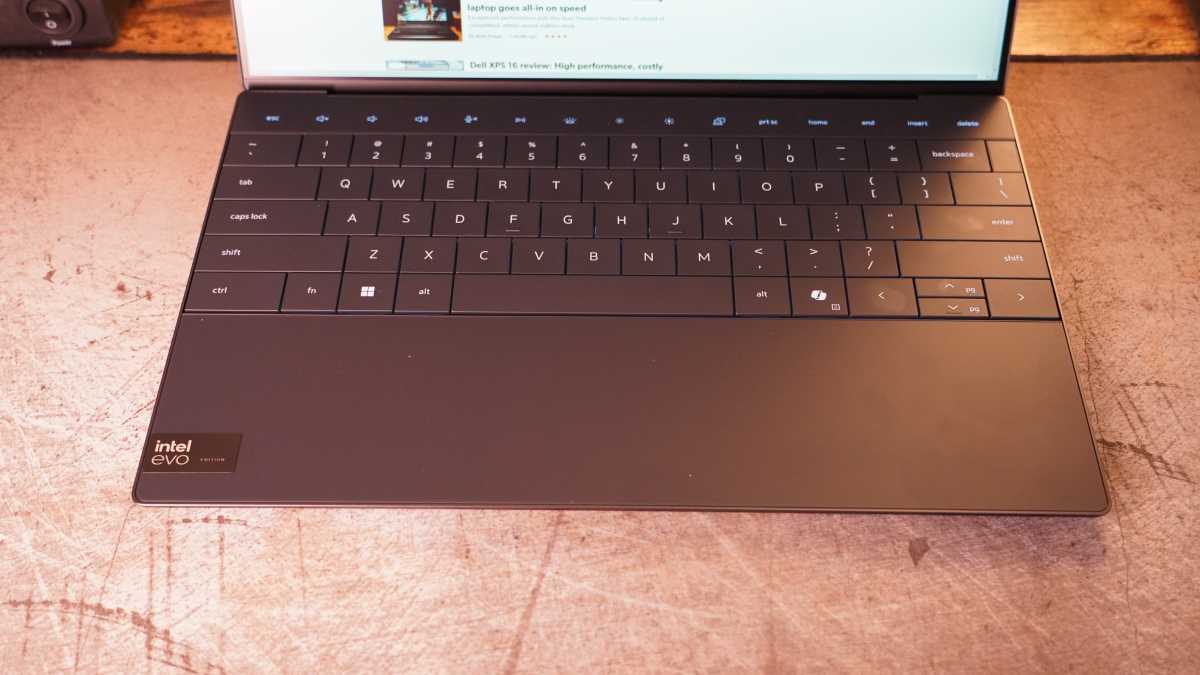
Mark Knapp / Foundry
I know Dell can make a great keyboard — the Inspiron 14 Plus’s keyboard stands as one of the best I’ve used — but this design ethos stands in the way of what might be excellent mechanics underneath.
At least touch navigation is solid. The trackpad on the XPS 13 isn’t nearly as big as it is on the XPS 14 or 16, extending from the left edge of the space bar to the right edge of the right Alt key roughly. It takes up most of the vertical space available to it. Since it’s almost impossible to avoid resting my palms on it, it’s good to see impeccable palm rejection from the trackpad. And where the XPS 14 tended to ignore any swipes if I started them from outside of the trackpad’s elusive boundaries, the XPS 13 will start to register them just as soon as my finger crosses the threshold of the trackpad. The trackpad also has a satisfying haptic feedback to clicks across most of its surface.
Dell XPS 13: Display, audio
You’ll find options from plain to presumably gorgeous for the XPS 13. Here we’ve tested the base display configuration, which is a 1920×1200 IPS panel. At its small 13.4-inch screen size, it’s reasonably sharp. The 30- to 120Hz refresh rate also provides smooth visual feedback while operating the system. While the upgraded, sharper options include touchscreens, this configuration doesn’t. It does include a strong anti-glare finish that combines with a high peak brightness (measured at 547 nits) for easy visibility in many scenarios, though. The clarity and visibility are the main pros of this display, and it offers a reasonably colorful and accurate panel that covers 99 percent of the sRGB color space, though it leaves plenty of room for improvement in the DCI-P3 color space. While nearly all colors were accurate with less than a dE of 2.0 (less than dE 1.0 for most), one shade of blue was off by a dE of 5.5 and could cause some issues for color-centric work.
Like the rest of the XPS line so far this year, the XPS 13 has impressive little speakers. They’re made all the more impressive with how small the laptop itself is. Listening to speech, the audio comes through loud and clear even at lower volume levels. Bumping the volume high can see the speaker rattle and distort a little, reverberating in the system, but there’s no denying these are potent speakers. Keeping the volume within tame levels, they have a nice balance to them and supply surprising bass.
Dell XPS 13 (2024): Webcam, microphone, biometrics
Dell’s 1080p webcam is a good one here. In addition to the satisfyingly sharp detail, it manages to offer natural color and even holds up in less-than-ideal lighting conditions, such as dimmer rooms. It can suffer from washed out images if too much light is in front of the lens. The webcam also serves up Windows Hello facial recognition for quick logins. A fingerprint scanner at the corner of the keyboard adds a second biometric option.
The mic system captures my voice well for calls, and eliminates some light background noise, but it’s not as successful at neutralizing other voices, such as a podcast I had playing from my phone at the side of the laptop.
There’s no denying that the Dell XPS 13’s speakers are potent, with a nice balance to them and supply surprising bass.
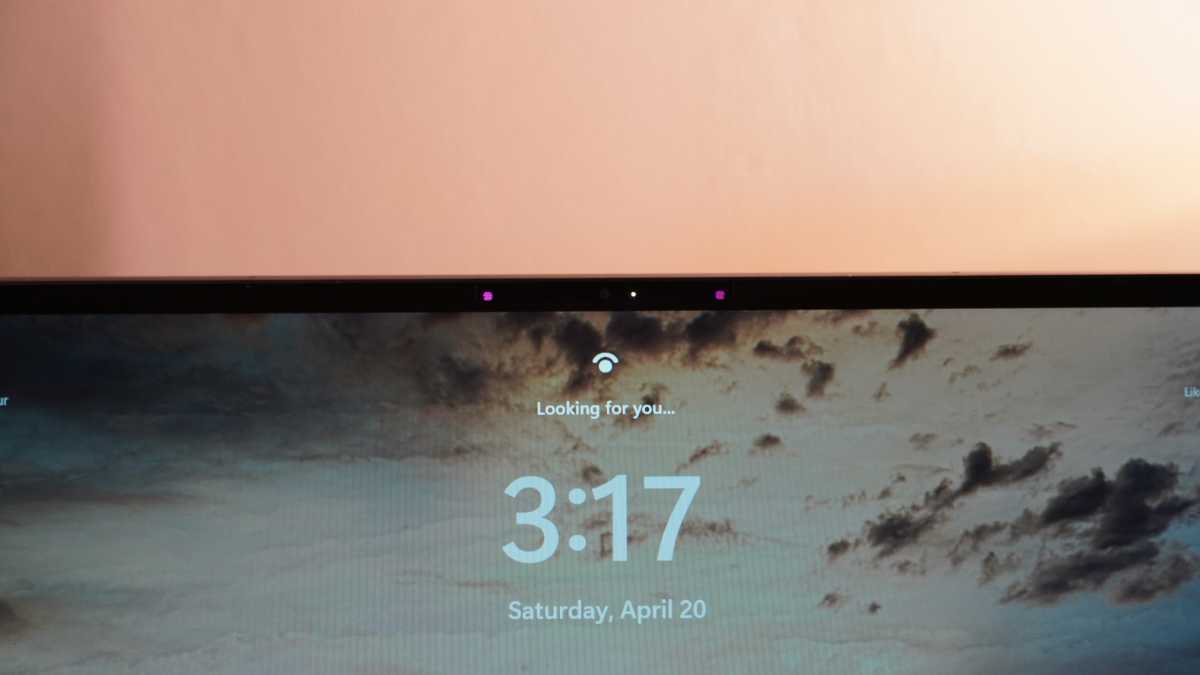
Mark Knapp / Foundry
Dell XPS 13: Connectivity
Dell offers strong wireless connectivity with Wi-Fi 7 and Bluetooth 5.4. My connections to earbuds and headphones have been stable, and the system is always quick to reconnect to Wi-Fi when it wakes up from sleep.
Wired connectivity is more of an issue, as Dell has fully embraced the modern ultrabook sensibilities. That is to say, it has just two USB-C ports. They are fully featured Thunderbolt 4 ports, at least, so they offer some serious expandability through docks. Dell even includes a handy dongle with a USB-A and HDMI port on it. But for simultaneous charging and connections to several peripherals, a proper dock will be necessary.
Dell XPS 13: Performance
The Dell XPS 13 is a solid performer, but when it comes to thin-and-light laptops, size does matter. The extra size of some of its competitors — 14-inch models that really aren’t a monstrous leap — highlight that the tight confines of the Dell XPS 13 may be strangling its potential in much the same way they did for the Dell XPS 16 compared to its larger competitors.
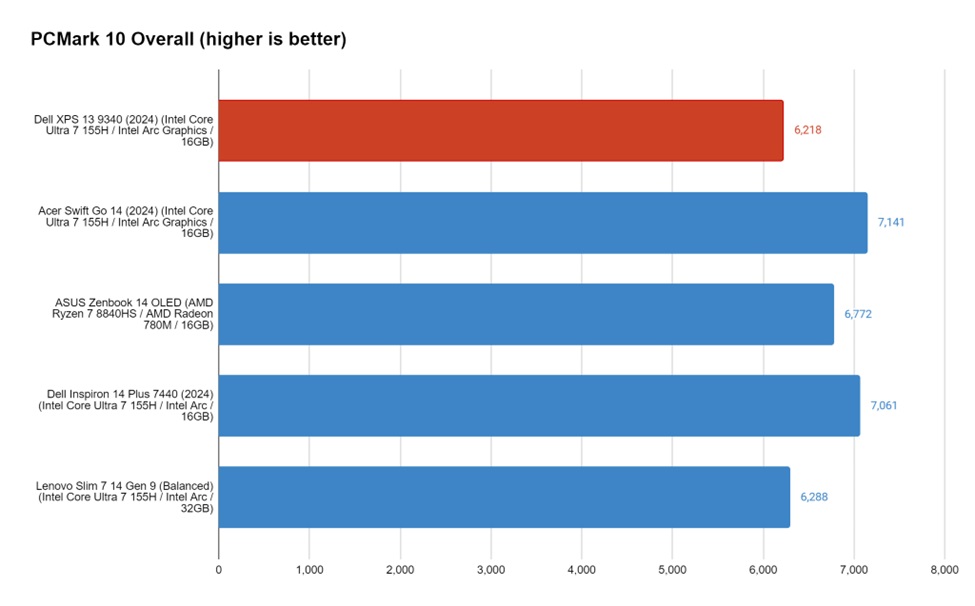
Mark Knapp / Foundry
We see the Dell XPS 13 still offering strong results in overall capabilities as marked by its PCMark 10 Overall score, which is an indicator of good utility at over 6,000 points. But the XPS 13 is trailing the pack here, lagging behind three other laptops fitted with the same CPU, and also trailing the Asus Zenbook 14 OLED with an Ryzen 7 8840HS processor. While memory and SSD speeds play into the PCMark results, we’ll see more clearly that the CPU in the XPS 13 ends up being what holds it back.
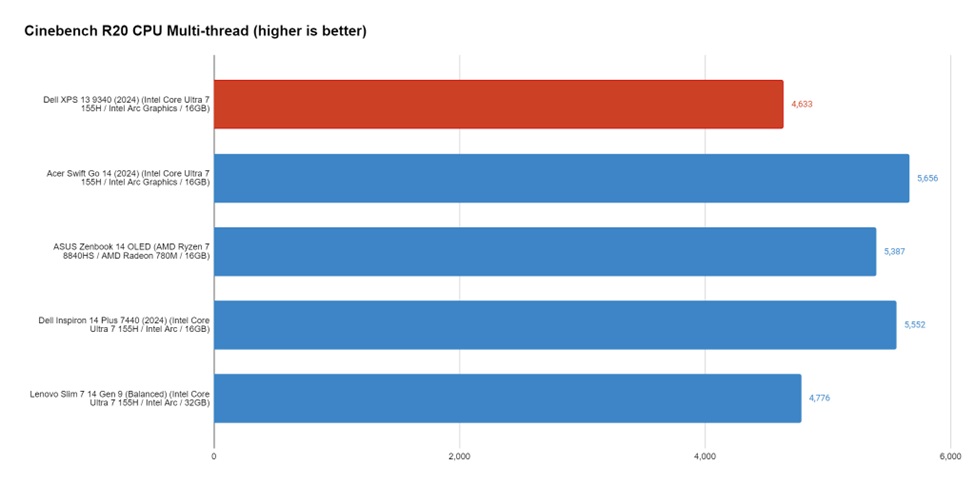
Mark Knapp / Foundry
Cinebench R20 puts stress particularly on the CPU, and here there’s similar daylight between the XPS 13 and its competition. The gaps between it and the other laptops almost perfectly mirror what we saw in PCMark. And since the XPS 13 packs the same CPU as most of these other laptops, it’s clearly just not squeezing out as much from the chip. Extended testing shows the score drop considerably lower, with a 10-minute run dropping it to 8,513, highlighting the inability to sustain high loads without thermals throttling the CPU.
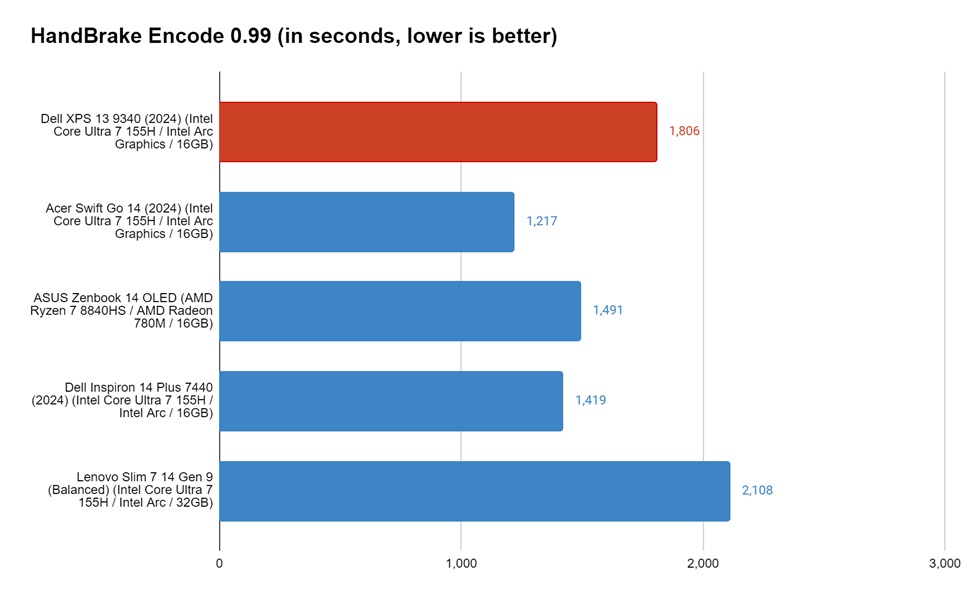
Mark Knapp / Foundry
Handbrake shows this same shortcoming. This extended test really taxes the CPU to encode a large video file. If the XPS 13 were able to keep thermals down and the CPU maxed out, it would likely have performed more in line with its competitors here. But as it stands, it lags well behind, taking a half hour to complete the task. Only the Lenovo Slim 7 14 Gen 9 fell behind.
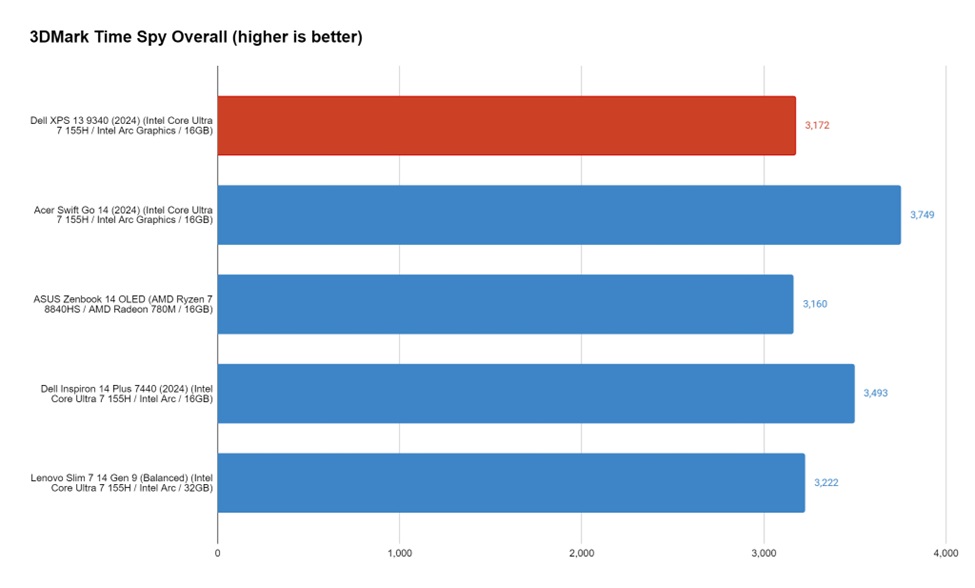
Mark Knapp / Foundry
Since the integrated Intel Arc Graphics are built right into the same chip as the CPU, they end up suffering from some of the same issues, though the disparities are reduced. Intel’s Arc Graphics prove modestly capable, but the Dell XPS 13 sees results that let competitors run ahead.
It’s all the more shameful for the XPS 13 that it’s more expensive than all four models it competes with here.
Dell XPS 13: Battery life
By all accounts, the XPS 13 is a wonder when it comes to battery life. It pulled off a staggering average over 14 hours in our test, which consists of a nonstop video playback with the display set to about 250 nits. However, this result is slightly soured by its competition. The same laptops that were able to push harder in performance prove just as capable or more of dialing back their performance to conserve battery life. While the Acer Swift Go 14 lags behind by just a few minutes, the Asus Zenbook 14 OLED and Dell Inspiron 14 Plus pull off an extra hour of runtime. Dell at least lands a solid win against the Lenovo Slim 7 14 Gen 9 here, which only mustered 11 hours (still respectable).
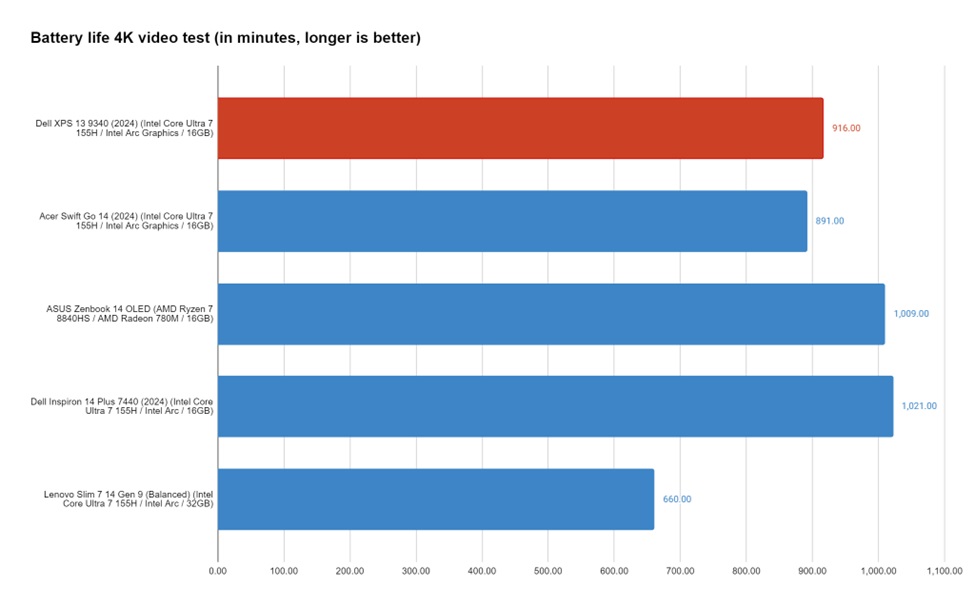
Mark Knapp / Foundry
In fairness to the Dell XPS 13, it has the smallest battery of the pack at just 54Wh, but that doesn’t lessen the fact that it will lag behind in real-world use. And the Asus Zenbook 14 OLED that so handily beat the XPS 13 here manages to do so with a 75Wh battery packed into a larger frame that only weighs 0.12 pounds more.
Should you buy the Dell XPS 13?
The Dell XPS 13 is a disappointment. It might be a beauty to behold, but it all crumbles underneath the utility. Dell’s new design makes for a keyboard that feels great on the individual key level but can be harder to navigate. And the premium design comes at a cost without also coming with boosted performance to justify it. In our tests, the XPS 13 generally lags behind its competitors by a notable margin, and they’re all significantly cheaper. And that’s with the base configuration in mind, which offers a simple IPS panel and compares poorly to the OLEDs a couple of its competitors are offering. It’s just too hard to justify springing for the XPS 13 when it’s beat on so many counts.





